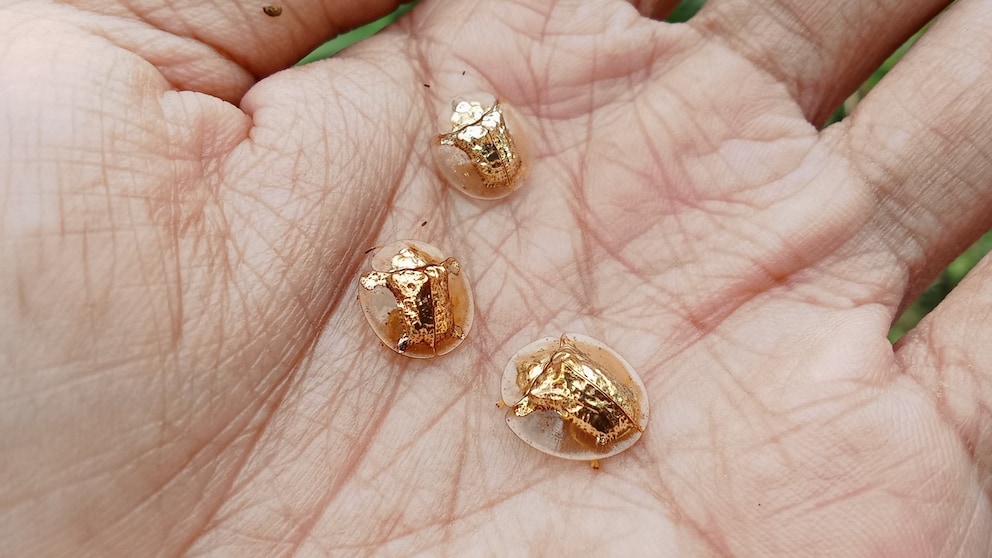April 13, 2025, 10:06 am | Read time: 4 minutes
Their shells sparkle like gold. Anyone seeing a picture of these beetles for the first time might assume that they are not real. But they really do exist. In fact, there are several species that have recently been delighting users on social media, in particular, with their magnificent shells.
Beetles come in a variety of colors, yet some are particularly enchanting to social media users. Under the term “Golden Tortoise Beetle,” photos and videos can be found in which the insects look like small gold coins. Consequently, many people initially question whether these are indeed “real” animals. But the golden tortoise beetles are not just real — there are several species that have such magnificent shells and are, therefore, easily confused with each other. PETBOOK takes a closer look at the golden tortoise beetles.
There Is More Than One Gold Coin Beetle
As if the phenomenon of beetles looking like little gold coins wasn’t bizarre enough, there are also several species to which this applies, all of which are often referred to as “Golden Tortoise Beetles.” However, all of them belong to the group of tortoise beetles. These can be recognized by the fact that their bodies are strongly flattened and slightly oval. The pronotum and elytra are significantly widened, causing the head and legs to be concealed beneath. The shape of shield beetles is, therefore, reminiscent of coins.
To simplify matters somewhat, this article will focus on the following two beetles:
- Aspidimorpha — a genus of shield beetles native to Asia, and
- Charidotella sexpunctata — a species of beetle found in North America and elsewhere.
Aspidimorpha
The genus Aspidimorpha comprises many hundreds of species. Not all of the beetles look like gold coins. Some also have dotted patterns in brown and red (Aspidimorpha miliaris). Species that are also known as golden shield beetles include Aspidimorpha furcata and Aspidimorpha sanctaecrucis. There are no German species names for either.
These insects have a body length of about 15 millimeters, which is slightly larger than that of a ladybug. The golden sheen of their carapace can vary and even disappear completely. For instance, images depict beetles of the same species with wing covers that shimmer golden in one photo while appearing an inconspicuous brown in others.1
The literature offers scant details on the mechanism behind this color change, particularly for the Aspidiomorpha species. However, it seems to be an ability that is observed in many golden shield beetles.
Charidotella sexpunctata
Beetles of this species also look like small gold coins. However, compared to the representatives of the genus Aspidimorpha, they are significantly smaller, with a body length of just five to seven millimeters. They can also change their color and even do so actively. This is already revealed by the species name of the beetles, as the term “sexpunctata” means “six spots.” These spots, for instance, become visible when the beetles are agitated. Then they change their color from a shiny gold to a reddish brown with black dots — probably to deter predators.2
But the beetles also change color during mating. How the beetles change color has not yet been investigated for Charidotella sexpunctata but has been studied for the closely related species Charidotella egregia. These beetles also look like gold coins when their wing covers are well supplied with fluid. If the beetles drain this fluid, the elytra appear reddish brown. This effect also causes dead beetles to lose their golden color.3
Presumably, other golden tortoise beetles also use this mechanism to change their color — but this has not yet been scientifically proven.
How to Tell the Golden Tortoise Beetles Apart
As the beetle species look confusingly similar to each other, they are often given the wrong Latin names. In reality, they represent two distinct genera with separate distribution ranges. However, they can also be distinguished by two characteristics: the size and the shape of the colored area on the elytra.
- Aspidimorpha: 15 mm in size, coloration of the elytra extended towards the head like a “Y”
- Charidotella sexpunctata: 5-6 mm in size, coloration of the elytra evenly round

What’s Behind the Colorful Pattern of the Picasso Shield Bug

Fireflies can be seen in these German regions

The 8 slowest animals in the world
Do the Golden Beetles Bring Luck?
In the United States, people might be delighted to encounter beetles resembling small gold coins. And it is sometimes claimed that the golden insects are lucky charms. However, the animals are extremely unpopular in their homeland. This is because both Aspidimorpha sanctaecrucis and Charidotella sexpunctata are considered agricultural pests.
Both beetle species primarily feed on sweet potato plants and related species, such as those in the bindweed family (Convolvulaceae). The larvae and adults eat small holes in the leaf surfaces so that often only the leaf veins remain. This often leads to the plants dying.4

